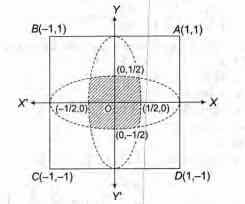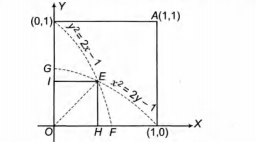Q.
Consider a square with vertices at (1,1), (-1, 1), (-1, -1)
and (1, -1). If S is the region consisting of all points
inside the square which are nearer to the origin than to
any edge. Then, sketch the region S and find its area.
Solution:
The equations of the sides of the square are as follow :
AB:y = 1, BC : x = - l , CD :y = - 1, DA : x= 1
Let the region be S and (x, y) is any point inside it.
Then, according to given conditions,
Now, in and , the first equation
represents a parabola with vertex at (, 0) and second
equation represents a parabola with vertex (, 0)
and in and , the first equation
represents a parabola with vertex at (0, ) and second
equation represents a parabola with vertex at (0, - ).
Therefore, the region S is lying inside the four parabolas
, , ,
where, S is the shaded region.
Now, S is symmetrical in all four quadrants, therefore
S = 4 x Area lying in the first quadrant.
Now, and intersect on the line
y = x The point of intersection is E(-1, -1).
Area of the region OEFO
= Area of OEH + Area of HEFH
= +
= +
=
= +
= +
= +
= +
== sq units
Similarly, area OEGO = sq units
Therefore, area of S lying in first quadrant
= sq units
Hence, S= sq units

